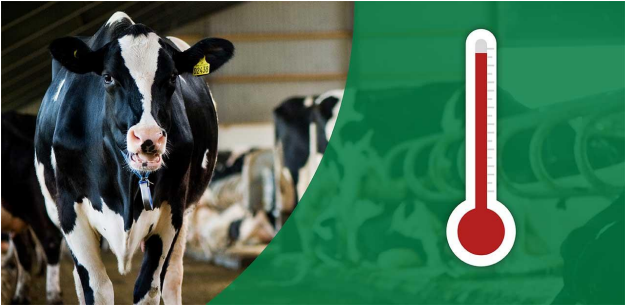
What is heat stress?
Cows generate heat by digesting feed and producing milk. They absorb solar heat when out in the sun. Heat stress occurs when cows generate and absorb more heat than they can easily get rid of by respiration, sweating, and air blowing by them (wind or fans). Heat stress leads to increased respiration rates, body temperatures, sweating, and time standing.
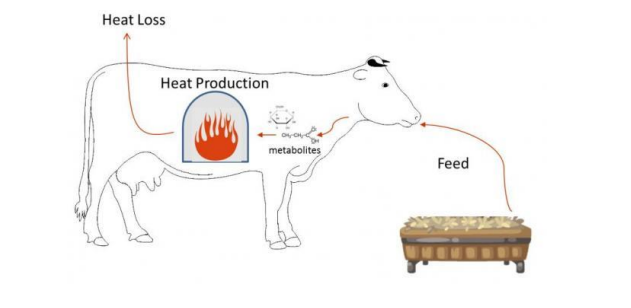
Why is heat stress an important issue?
- Heat stress costs heavy loss to the farmers.
- Heat-stressed lactating cows have reduced dry matter intake, milk production, and pregnancy rates.
- Heat stress also leads to increased lameness, disease incidence, days open, and death rates.
- Heat-stressed late gestation cows have shorter gestation periods, calves with lower birth weights, reduced milk production, and impaired immune function.
- Heifer calves from heat-stressed cows produce less milk for the first 30 weeks of lactation after freshening.
When do cows start to become heat-stressed?
- Cows begin to experience heat stress at much lower temperatures than humans. In general, mild heat stress starts around 72°F with 50% humidity.
- High-producing cows eat more and generate more heat. They can begin to experience heat stress in well-ventilated barns at air temperatures as low as 65°F.
- The temperature-humidity index (THI) takes into account both temperature and humidity to estimate the level of heat stress cows will experience based on environmental conditions.
Heat stress levels and effects on the body:
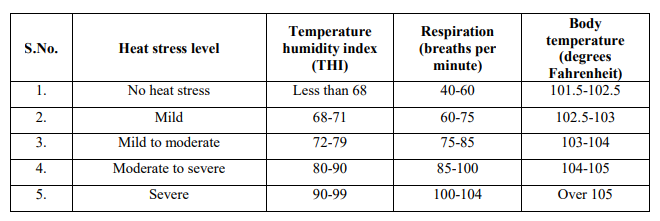
How do we know if a cow is heat-stressed?
1. Respiration and Body Temperature:
- Respiration rates and body temperature are both good ways to assess how well cows are managing their heat production and losses in warm weather.
- Individual cow responses will vary and conditions change throughout the day. We can observe and record respiration rates or measure body temperatures at different times of the day to assess how well the cows are coping with the weather conditions.
- We also can monitor daily milk production, but declines in milk production are commonly delayed two or more days after cows begin to experience heat stress.
2. Physical Appearance:
- Cows experiencing mild heat stress may not show clinical signs at all.
- Cows experiencing severe heat stress usually breathe with their mouths open and pant with their necks extended. They are lethargic and may appear unsteady.
3. Respiration rates:
- Respiration rates are the recommended measure of heat stress because there is little to no lag time compared to body temperatures and milk production.
- Normal respiratory rates for adult dairy cattle range from 40 to 60 breaths per minute (bpm).
- If more than 10% of cows have a respiratory rate exceeding 100 bpm, the situation is considered an emergency, and immediate action should be taken.
4. Body temperature:
- Body temperature gives a direct measure of an individual cow’s heat stress level.
- Normal body temperature for an adult cow is 101.5 to 102.5 degrees F.
- If more than 5-10% of cows have a body temperature above 105 degrees F, the situation is considered an emergency, and immediate action should be taken.
5. Milk Production:
- Milk production decreases as the level of heat stress increases.
- Mild heat stress results in a production decrease of about 2.5 lbs. per head per day.
- Mild to moderate heat stress results in a production decrease of about 6 lbs./head/day.
- Moderate to severe heat stress results in a production decrease of about 9 lbs./head/day.
- Severe heat stress is a life-threatening condition and production decreases exceed 10 lbs./head/day.
How to prevent heat stress in dairy cows?
Many dairy farmers use multiple practices to help their cows manage their body temperature in hot,
humid and sunny weather.
1. Shade:
- Shade can help reduce the solar heat load and remains one of the first recommendations to help lactating cows and dry cows manage their heat load in hot weather.
- Well-ventilated barns and pole sheds are good options for providing shade. There are numerous shade structure options available from building suppliers.
- When providing shade, it is important to provide plenty of shade for all of the animals at the same time without crowding. Around 40 square feet per animal is recommended.
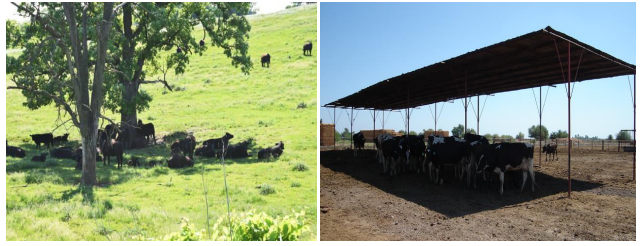
2. Ventilation:
Air exchange:
- Barn ventilation cools cows by providing air exchange between inside and outside. Ventilation can be done by either natural or mechanical means.
- In hot weather, we should provide as much air exchange as possible. Usually, this is between 60 and 90 air exchanges per hour.
- Tunnel ventilation brings air in at one end of a barn and exhausts it out at the other.
- We should optimize the size of fans and inlets correctly and we should make sure the fans are well maintained and inlets are open to get the desired air velocity.
- Cross ventilation brings air in on the side of the barn and exhausts it out the other side.
- Cross-vent barns often use a series of baffles to try to keep the air at cow level and increase the air velocity at cow level.
- Size of fans and inlets should be kept correctly. We should make sure the fans are well maintained and inlets are open to get the desired air velocity.
- Natural ventilation depends mainly on the wind in hot weather.
- Open ridges allow some hot air to escape out the ridge.
- Fresh air enters through the open sides of the barn.
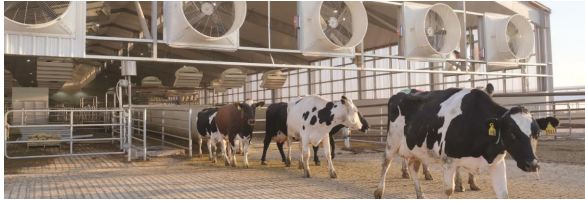
Air velocity
- Increasing the air velocity flowing past a cow can help her get rid of heat. Tunnel ventilation, cross-ventilation with baffles, and high-speed mixing fans are ways to increase the air velocity past a cow.
- Mixing fans can be mounted above free stalls and feed alleys where cows stand to eat.
- Many fans generate air velocities over ten mph past the cows.
- Mixing fans need to be mounted high enough to not be a hazard to people, cows, or equipment moving underneath the fans.
- Point high-speed fans slightly downward (20 degrees) so the air blows past the cows.
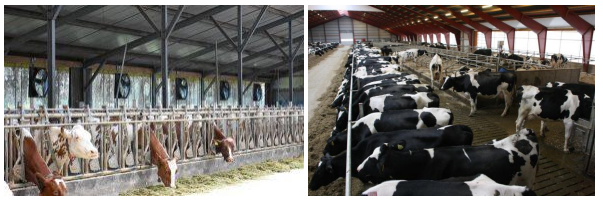
3. Cooling with Water:
- Sprinklers and misters help cows get rid of body heat.
- Sprinklers wet the cow’s skin, and her body heat is used to evaporate the liquid water on the skin.
- Misting systems cool the air by evaporating water droplets using heat in the air.
- Both methods increase the air’s relative humidity, but if the barn is well ventilated, the humidity levels should not become excessive.
- Sprinklers and misters are more effective in drier weather with lower dew-point temperatures.
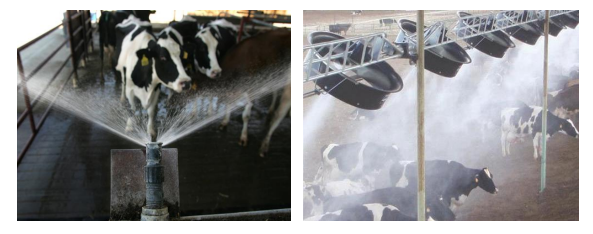
- Sprinklers need to cycle on and off to allow time for water evaporation.
- Avoid excessive sprinkling that causes water to run down and wet the udder because this can lead to an increased risk of mastitis.
- With high-pressure misters, the droplets need to evaporate before they hit the stalls or bedding.
- Misters should be placed near the inlets.
- Misters are not as effective when ventilation blows the mist out of the barn before the air cools.
4. Drinking water:
Hydration is incredibly important for a cow to regulate body temperature, both during times of heat stress and cold stress. Adequate drinking water should be supplied at all times.
- In hot weather (90-95 degrees F for a high daytime temperature), a lactating cow producing 80-100 lbs of milk drinks 25-35 gallons of water per day.
- The recommended amount of space is two linear inches of water space per cow. Consider increasing water space during hot weather.
- Water troughs should be at least three inches deep to allow cows to submerge their muzzle when drinking.
- Cows consume up to 50% of their daily water intake following milking.
- We should make sure that the water flow to the trough and water capacity is adequate to account for large quantities needed at all at once.
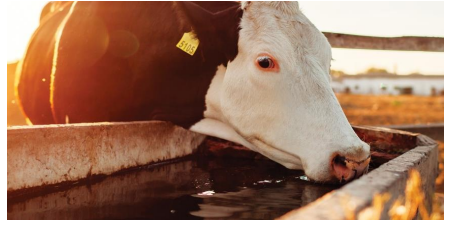
5. Holding area cooling:
- Milking center holding areas need special attention paid to ventilation and cooling in warm weather to avoid heat stress.
- Cows can be crowded in the holding area for up to an hour. A crowded pen reduces the airflow around a cow and can make it more difficult for her to avoid heat stress.
Conclusions
At high temperatures, evaporative cooling is the principal mechanism for heat dissipation in cattle. It is influenced by humidity and wind speed and by physiological factors such as respiration rate, and density and activity of sweat glands. In hot weather, cattle actively seek shade, which may reduce the radiant heat load by 30% or more. Under conditions of extreme heat load, shading and other strategic heat
reduction system may maintain the milk production of the animals and reduce deaths from heat stroke. Therefore, an effective cooling system should definitely be implemented during summer to prevent the animals from summer heat stress.
Authors:
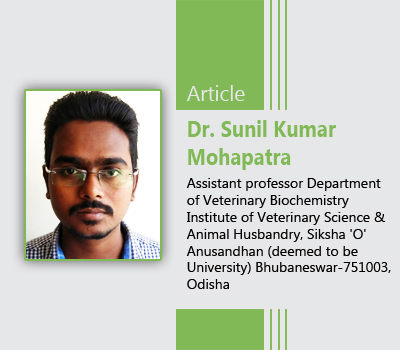
1st Dr. Sunil Kumar Mohapatra
Assistant Professor
Department of Veterinary Biochemistry
Institute of Veterinary Science & Animal Husbandry,
Siksha ‘O’ Anusandhan (Deemed to be university)
Bhubaneswar-751003, Odisha
2nd Dr. Md. Mofijul Islam
Assistant Professor
Department of Veterinary Anatomy
Institute of Veterinary Science & Animal Husbandry,
Siksha ‘O’ Anusandhan (Deemed to be university)
Bhubaneswar-751003, Odisha
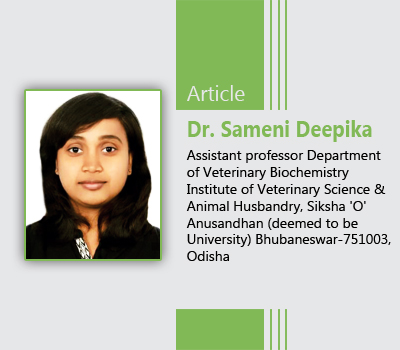
3rd Dr. Sameni Deepika
Assistant Professor
Department of Veterinary Biochemistry
Institute of Veterinary Science & Animal Husbandry,
Siksha ‘O’ Anusandhan (Deemed to be university)
Bhubaneswar-751003, Odisha
4th Dr. Sanjeev Kumar
Assistant Professor
Department of Veterinary Microbiology
Institute of Veterinary Science & Animal Husbandry,
Siksha ‘O’ Anusandhan (Deemed to be university)
Bhubaneswar-751003, Odisha

















